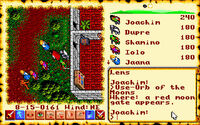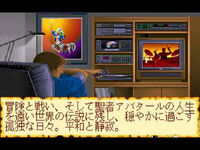Ultima VI was the last game in the series to receive a port to various systems. The gap between the ever-growing PC technology and the other systems started to become really noticeable and caused Origin to make the decision to solely produce the games on the PC in the future.
The SNES-Port of Ultima VI is not discussed here, it has a separate article.
The IBM-PC Original[]

IBM-PC title screen

IBM-PC in-game
The original game for the first time was developed on a IBM-PC, after development on the Apple II was scrapped. As far as known, Richard Garriott tried to develop the game on the Apple II for almost a year, before giving up. This is very noticeable right away.
The game is much more detailed than its predecessors with everything being on a single-scale map. The graphics are now shown in 256 color VGA at a resolution of 320x200. It makes a huge difference, all the black of the previous installments has vanished from the screen, Britannia now looks really alive and very colorful.
Sound is also a new feature on the PC. While previous installments on the PC didn't have the music of the others ports, Ultima VI has it from the start since by 1990, sound cards for the PC were available. The music can play on something low-class as an Adlib card up to high-end sound boards like Roland Sound. However, sound effects were still only put out through the PC speaker.
Also the game is finally fully playable with the mouse and icon driven. The interface of Ultima VI is a lot more user-friendly than the previous ones, enabling even beginners to play the game. Only conversations still had to be typed manually.
The game was retailed on either four 3.5" floppies or seven 5.25" floppies.
The Amiga and Atari ST Ports[]

Atari ST intro

Atari ST in-game

Amiga in-game
The Amiga and Atari ST ports of Ultima VI were based on the PC original. By now the limitations of these two computer systems became painfully obvious.
Since the Amiga could only display a maximum of 32 colors at the same time and the Atari ST 16 colors, the VGA graphics simply couldn't be used. So they took the VGA graphics of the original and converted them to the palette of the two systems. While the result on the Amiga was pretty good for the plaform, the Atari ST version was rather ugly with many color artifacts. This is especially noticeable in the introduction and the character portraits. On the Atari, the graphics also have a reddish tint that is rather distracting.
Sound is another issue. The full soundtrack of the PC original was impossible to implement because of the strain the game put on computer power and floppy space. To compensate, the music was vastly reduced: some tracks such as the Ultima Theme or Audchar Gargl Zenmur were simply removed and other tracks were simplified beyond recognition, notably Stones.
The ports are both very slow since only meager reprogramming was done and the computers just couldn't handle the engine, resulting in a game that essentially still would run better on a PC. Also the number of floppy disks (three 3.5" for the Amiga and four 3.5" for the Atari ST) make the game inconvenient to use (require for instance to switch floppy every time you speak to a NPC). While this issue could be resolved if the game was installed on a hard drive, those were unfortunately not common amongst Amiga and Atari ST users. Interestingly, the game ran with a much better speed if used on an Amiga 1200 or an Atari Falcon, thus resulting in fewer frustrations for the users, but considering the commercial failure of both of these computers it unfortunately concerned very few people.
The C64-Port[]
This port, the only 8-bit port of the game, was changed so much, that it has got its own article: C64-Port of Ultima VI.
The FM-Towns Port[]

FM-Towns 1

FM-Towns 2

The talking system of the FM-Towns
This port is something different. Graphically and content-wise, the port is a replica of the PC original. The music was overhauled and sounded nicer than the Soundblaster of the original and there are now proper sound effects. However, there are several things that make the Japan-only port stick out:
Besides an English mode, the game also has a Kanji mode, which is shown in the screenshots.
The most important thing is that the game has a complete voice track. It is notable that mostly the people from Origin representing the characters (like Richard Garriott voicing Lord British and David Watson voicing Iolo) were used, but not all, since not everyone was available.
Even though it seemed like a great idea, the voice track is legendarily bad, as at that time Origin had little experience with voicing video games. Also, the developers usually weren't trained voice actors (the intro of Ultima VII Part Two proves this with Richard Garriott).
Another difference to the original is the fact that the conversation system had been overhauled. It is now similar to Ultima VII, with the player only being able to speak about topics that the Avatar is expected to know about. This closes numerous shortcuts in the game and makes sure that the plot has to be followed. This also means that the cheat menu had been removed.
Note that the screen layout didn't need to be redesigned since the higher resolution of the FM-Towns made it possible to store more screen content. The higher resolution also means that when there isn't a conversation, the game-system icons occupy the lower fourth of the screen.
In the main menu, another point named "voice credits" had been added, while the copy protection had been removed from the game.
| Computer Ports | |
|---|---|
| Games | Ultima I ☥ Ultima II ☥ Ultima III ☥ Ultima IV ☥ Ultima V ☥ Ultima VI |